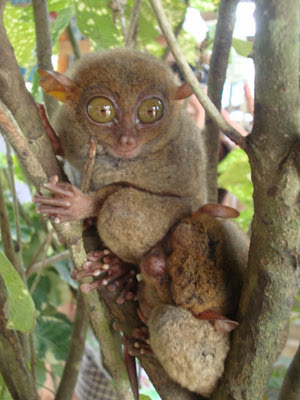The Philippine tarsier is one of the most unique and peculiar animals on the planet. I have seen this creature several times and it is really very cute and adorable. It is very small that I wish to have one hang on my bag’s zipper or with my keys. LOL! On a serious note, the tarsier deserves some respect and attention as it is under endangered status already. Well, here are some facts about the Philippine tarsier that you may not know:
- Measuring only 85 to 160 millimeters (3.35 to 6.30 in) in height, the Philippine tarsier is one of the smallest primates. It is about the size of a human fist and will fit very comfortably in the human hand.
- The tarsier’s eyes are fixed in its skull, meaning it can be turned in their sockets. So if it wants to see what’s beside and behind it, it has to turn its entire head. This is a special adaptation for its neck which allows its round head to be rotated 180 degrees.
- It also has one of the largest eyes. In fact, it has the largest eye-to-body size ratio of all mammals. Its huge eyes provide excellent vision, especially during nights.
- The tarsier has very long tail, about twice its body length. It is usually naked or bald except for a tuft of hair at the end. It uses this long tail to achieve balance.
- Its name is taken from the term “tarsus,” referring to its ankle bone. This bone allows the tarsier to jump at least three meters from tree to tree without touching the ground. This is jumping as much as 40 times their length.
- The tarsier prefers to live in dense, low-level vegetation in secondary forests. It loves tall grasses, bushes, and bamboo shoots.
- Both male and female tarsiers are solitary animals, meaning, they love being alone.
- Tarsiers are nocturnal. During the day, they sleep in holes in the ground and tree trunks. They become active only during the night.
- A tarsier can travel up to one and a half kilometers across the forest when it hunts for prey at night.
- It preys on live insects like crickets and grasshoppers, small crustaceans, spiders, and small vertebrates like small lizards and birds.
- Tarsiers are prey to cats (like feral cats) and birds (like owls).
- The Philippine tarsier is found in the islands of Bohol, Samar and Leyte, and even in Mindanao. It has also been found on many isolated islands including Maripipi Island, Siargao Island, Basilan Island and Dinagat Island.
- The pregnancy for female tarsier last for 6 months. When the baby is born, its eyes are open. The infant is born with lots of hair too. The females carry their infants in their mouths.
- Threats to their population include human population increase, loss of natural habitat, hunting for trade, urbanization, and introduction of predators.


شركة نقل عفش
ReplyDeleteشركة نقل عفش بجدة
شركة نقل عفش بالطائف
شركة نقل عفش بالمدينة المنورة